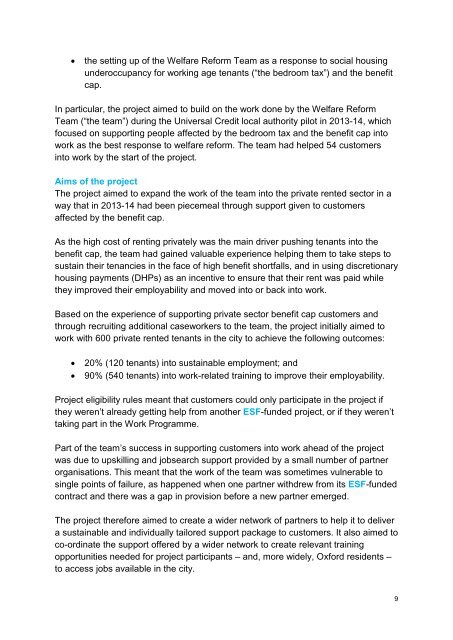Welfare Reform Team Evaluation of European Social Fund pilot project 2014-2015
welfare_reform_european_social_fund_project_evaluation_report
welfare_reform_european_social_fund_project_evaluation_report
Create successful ePaper yourself
Turn your PDF publications into a flip-book with our unique Google optimized e-Paper software.
• the setting up <strong>of</strong> the <strong>Welfare</strong> <strong>Reform</strong> <strong>Team</strong> as a response to social housing<br />
underoccupancy for working age tenants (“the bedroom tax”) and the benefit<br />
cap.<br />
In particular, the <strong>project</strong> aimed to build on the work done by the <strong>Welfare</strong> <strong>Reform</strong><br />
<strong>Team</strong> (“the team”) during the Universal Credit local authority <strong>pilot</strong> in 2013-14, which<br />
focused on supporting people affected by the bedroom tax and the benefit cap into<br />
work as the best response to welfare reform. The team had helped 54 customers<br />
into work by the start <strong>of</strong> the <strong>project</strong>.<br />
Aims <strong>of</strong> the <strong>project</strong><br />
The <strong>project</strong> aimed to expand the work <strong>of</strong> the team into the private rented sector in a<br />
way that in 2013-14 had been piecemeal through support given to customers<br />
affected by the benefit cap.<br />
As the high cost <strong>of</strong> renting privately was the main driver pushing tenants into the<br />
benefit cap, the team had gained valuable experience helping them to take steps to<br />
sustain their tenancies in the face <strong>of</strong> high benefit shortfalls, and in using discretionary<br />
housing payments (DHPs) as an incentive to ensure that their rent was paid while<br />
they improved their employability and moved into or back into work.<br />
Based on the experience <strong>of</strong> supporting private sector benefit cap customers and<br />
through recruiting additional caseworkers to the team, the <strong>project</strong> initially aimed to<br />
work with 600 private rented tenants in the city to achieve the following outcomes:<br />
• 20% (120 tenants) into sustainable employment; and<br />
• 90% (540 tenants) into work-related training to improve their employability.<br />
Project eligibility rules meant that customers could only participate in the <strong>project</strong> if<br />
they weren’t already getting help from another ESF-funded <strong>project</strong>, or if they weren’t<br />
taking part in the Work Programme.<br />
Part <strong>of</strong> the team’s success in supporting customers into work ahead <strong>of</strong> the <strong>project</strong><br />
was due to upskilling and jobsearch support provided by a small number <strong>of</strong> partner<br />
organisations. This meant that the work <strong>of</strong> the team was sometimes vulnerable to<br />
single points <strong>of</strong> failure, as happened when one partner withdrew from its ESF-funded<br />
contract and there was a gap in provision before a new partner emerged.<br />
The <strong>project</strong> therefore aimed to create a wider network <strong>of</strong> partners to help it to deliver<br />
a sustainable and individually tailored support package to customers. It also aimed to<br />
co-ordinate the support <strong>of</strong>fered by a wider network to create relevant training<br />
opportunities needed for <strong>project</strong> participants – and, more widely, Oxford residents –<br />
to access jobs available in the city.<br />
9




